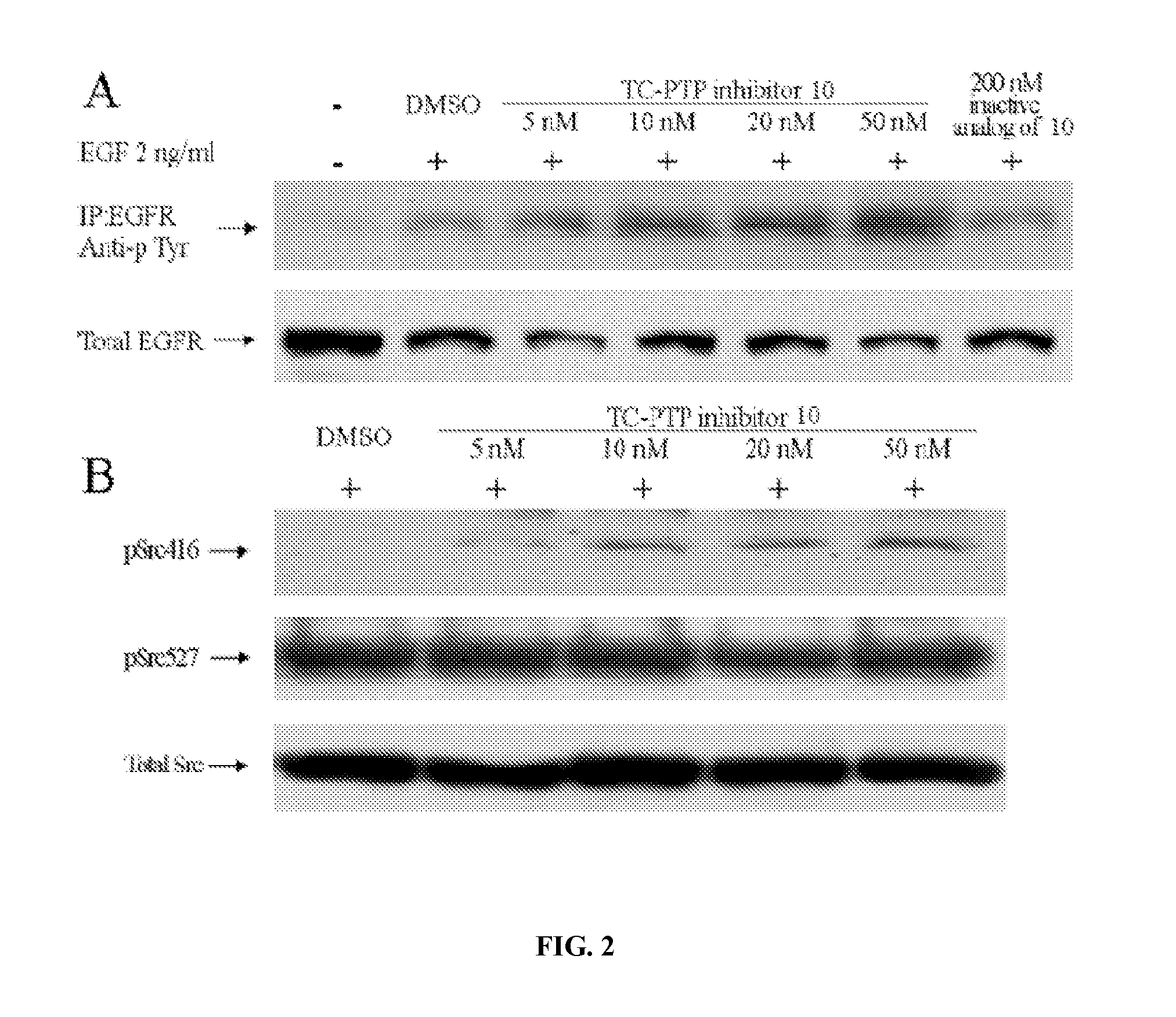Inhibitors of protein tyrosine phosphatases
a technology of protein tyrosine phosphatase and inhibitors, which is applied in the direction of drug compositions, immunological disorders, metabolism disorders, etc., can solve the problem of problematic development of selective ptp inhibitors
- Summary
- Abstract
- Description
- Claims
- Application Information
AI Technical Summary
Benefits of technology
Problems solved by technology
Method used
Image
Examples
example 2
Synthesis of Compound 4
[0050]Compound 4 was synthesized according Scheme S1, on Rink amide resin (ADVANCED CHEMTECH) using standard Fmoc chemistry. The resin (200 mg, 0.5 mmol / g loading) was first activated with DCM (general procedure A). Resin was then treated with 30% piperidine to remove the Fmoc group (general procedure B). The resin was coupled with Fmoc-Lys(Alloc)-OH (general procedure D). The Alloc group was removed using general procedure C, and resin was coupled with AcOH. The Fmoc group was then removed and resin was coupled with Fmoc-F2Pmp-OH. The Fmoc group was removed and resin was coupled with AcOH. Compound 4 was then cleaved from resin (General procedure E). The crude peptide was purified by HPLC to afford 4 (12.3 mg, 24% yield). Mass calculated for [M] 506. found [M+H]+ 507.
example 3
Synthesis of Precursor 5 for the First Generation Library
[0051]Synthesis of Compound S1. Compound S1 was synthesized according Scheme S2, on Rink amide resin (ADVANCED CHEMTECH) using standard Fmoc chemistry. The resin (200 mg, 0.5 mmol / g loading) was first activated (general procedure A). Then Fmoc group was removed with 30% piperidine in DMF (general procedure B). The resin was then coupled with Fmoc-Lys(Boc)-OH (general procedure D). The resin was then sequentially coupled with Fmoc-Ala-OH, Fmoc-Lys(Alloc)-OH, Fmoc-F2Pmp-OH and AcOH. The Alloc group was then removed (general procedure C). The resin was shaken with Fmoc-Cl (0.2 M in DMF, 2.5 mL) and NMM (1.5 M in DMF, 0.5 mL) for 2 hours. The compound S1 was then cleaved from resin (general procedure E). Crude peptide was purified by HPLC to afford S1 (24.3 mg, 27% yield). Mass calculated for [M] 885. found [M+H]+ 886.
[0052]Synthesis of Compound S2. Compound S1 (24.3 mg) was treated with 5(6)-FAM SE (20 mg) and NMM (0.1 mL) in DMF...
example 4
Synthesis of Compound 6
[0054]Compound 6 was synthesized according Scheme S3, on Rink amide resin (ADVANCED CHEMTECH) using standard Fmoc chemistry. The resin (200 mg, 0.5 mmol / g loading) was first activated (general procedure A). The resin was treated with 30% piperidine to remove the Fmoc group (general procedure B). The resin was coupled with Fmoc-Lys(Alloc)-OH (general procedure D). The Alloc group was removed (general procedure C) and resin was coupled with 4-ethylbenzoic acid. After removal of Fmoc group, resin was then coupled with Fmoc-F2Pmp-OH and AcOH sequentially. Compound 6 was then cleaved from resin (general procedure E). The crude product was purified by HPLC to afford 6 (15.8 mg, 27% yield). Mass calculated for [M] 596. found [M+H]+ 597.
Example 5
Synthesis of Precursor 7 for the Second Generation Library
[0055]Synthesis of Compound S3. Compound S3 was synthesized according scheme S4, on Rink amide resin (ADVANCED CHEMTECH) using standard Fmoc chemistry. The resin (200 m...
PUM
| Property | Measurement | Unit |
|---|---|---|
| body weight | aaaaa | aaaaa |
| body weight | aaaaa | aaaaa |
| body weight | aaaaa | aaaaa |
Abstract
Description
Claims
Application Information
 Login to View More
Login to View More - R&D
- Intellectual Property
- Life Sciences
- Materials
- Tech Scout
- Unparalleled Data Quality
- Higher Quality Content
- 60% Fewer Hallucinations
Browse by: Latest US Patents, China's latest patents, Technical Efficacy Thesaurus, Application Domain, Technology Topic, Popular Technical Reports.
© 2025 PatSnap. All rights reserved.Legal|Privacy policy|Modern Slavery Act Transparency Statement|Sitemap|About US| Contact US: help@patsnap.com



